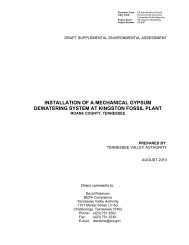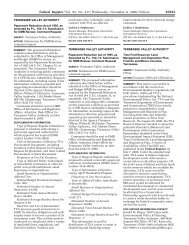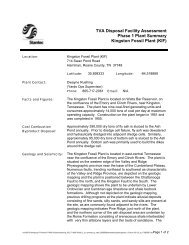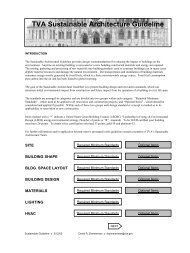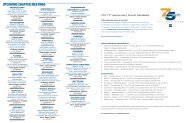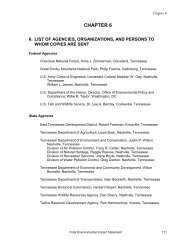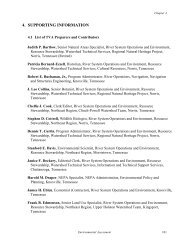Corrective Action Plan - Tennessee Valley Authority
Corrective Action Plan - Tennessee Valley Authority
Corrective Action Plan - Tennessee Valley Authority
You also want an ePaper? Increase the reach of your titles
YUMPU automatically turns print PDFs into web optimized ePapers that Google loves.
Kingston Ash Release March 2009<br />
<strong>Corrective</strong> <strong>Action</strong> <strong>Plan</strong><br />
During the ash cleanup period, observation wells will be installed in relevant aquifers at selected<br />
locations in ash impacted areas to acquire data such as groundwater elevations, both prior to<br />
and during cleanup. Data will be used to evaluate groundwater gradients and gradient changes<br />
in response to changes in reservoir stage and to pumping of one or more wells. Observation<br />
wells may be equipped with continuous pressure transducer data recorders. An additional<br />
pressure transducer/recorder may also be placed in the reservoir and monitored in conjunction<br />
with observational well systems.<br />
4.2 OFFSITE PRIVATE WATER SUPPLY WELLS AND SPRINGS<br />
Residential well water sampling is currently being conducted by TDEC. TDEC has sampled<br />
residential well water within a 4-mile radius of the ash spill (Figure 4.1). On-going groundwater<br />
monitoring to ensure protection of offsite private water-supply wells and springs during the<br />
cleanup phase will be performed within the region proposed on Figure 4.3. The primary<br />
groundwater contamination pathway of concern for offsite groundwater supplies is infiltration of<br />
ash leachate below the ash laden land bordering the Emory River and its tributaries. Shallow<br />
groundwater movement within each tributary watershed is expected to generally follow<br />
topographic slope, i.e., with groundwater migrating down slope and ultimately discharging into<br />
the stream. Any potential chemicals leaching from ash deposited along stream margins would<br />
be expected to generally flow toward the stream. On this basis, the monitoring region shown on<br />
Figure 4.3 is generally confined to the lower portions of the watersheds associated with ashimpacted<br />
tributary streams on the west side of the Emory River. The region of monitoring<br />
conservatively extends approximately 0.25 mile upslope of ash-impacted land and surface<br />
water. This 0.25-mile buffer allows for uncertainties regarding localized groundwater flow<br />
direction that can occur in fractured bedrock aquifers. Potential gradient reverse issues will be<br />
evaluated as part of the overall groundwater monitoring program to be developed in conjunction<br />
with the regulators.<br />
On the east side of the Emory River, groundwater monitoring will be limited to river frontage<br />
properties having wells located directly across the river from the ash-filled portion of the channel<br />
(Figure 4.3). Although no ash-impacted land is present on or near these properties, monitoring<br />
will be performed to assure there is no transport of ash-related chemicals from ash deposits in<br />
the river channel to groundwater supplies due to hydraulic gradient reversals caused by overpumping<br />
of wells or seasonal changes in reservoir stage.<br />
Forty-seven (47) land parcels having inferred well or spring supplies are indicated within the<br />
designated offsite groundwater monitoring region. Information regarding land parcels with<br />
inferred private or individual water supplies on Figure 4.3 was provided by Roane County<br />
Emergency Management, and is based on property records and records of residents served by<br />
local public water systems. Examination of recent photo imagery indicates some of these<br />
parcels are undeveloped and probably have no water supply. The status of existing well or<br />
spring supplies within the monitoring region will be confirmed during the first monitoring event.<br />
In addition, an attempt will be made during that event to obtain additional information regarding<br />
each groundwater supply (e.g., well depth, screened interval, aquifer penetrated, water usage<br />
rate, etc.).<br />
Wells or springs located on properties impacted by ash deposits or within approximately 500<br />
feet of ash deposits will be sampled quarterly during the first year. Other wells and springs in<br />
the designated monitoring region will be sampled semiannually. The frequency of monitoring of<br />
each well and spring will be re-evaluated annually based on monitoring results and proximity to<br />
ash laden areas.<br />
4-4





